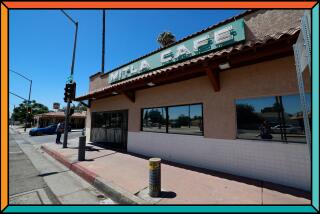Shop Owners Cry Foul After Buyout by City
- Share via
Jorge and Maria Merino are both 60 years old, and the Anaheim Hills couple say there is not a large market for employers looking to hire people their age.
For the last year, the immigrants from Argentina, now U.S. citizens, have unsuccessfully applied for jobs as bakers. Their names sit in the state registry of the Employment Development Department but nobody has called. Jorge Merino says trade schools won’t accept him because he’s too old.
These were to be the golden years for the Merinos, after 14 years of running the popular South Coast Bakery on South Bristol Street, which netted the couple $60,000 a year after expenses. They had hoped to ease into retirement within a few years.
But the city of Santa Ana needed their property for the Bristol Street widening and the Merinos sold it last year for $790,000, with the understanding that whatever piece of land wasn’t used would be packaged with adjoining property that the city would turn into a shopping center. The Merinos’ bakery would be the anchor of the 11-store mall and the couple could have the newly joined property at no cost or below market value.
Though the Merinos had an appraisal in hand for $978,000, they said the city urged them to accept the lower figure in exchange for the city’s agreement to help the couple develop the shopping center, at Bristol Street and Wilshire Avenue.
And at the city’s urging, Jorge Merino said, he spent $140,000 for an architect, a soil engineer and other experts to do studies and draw up plans for the center.
“They made us promises from the beginning, telling us not to worry because the city wanted to find a way to work with us,” said Jorge Merino, fighting back tears. “We believed them. We were working seven days a week, 14 hours a day and had seven employees. We wanted to keep our business and pass it on to our sons. We believed everything they told us.”
They even point to an August 1995 letter from Michael Hennessey, the city’s real estate officer at the time, which confirms “the city’s ongoing efforts to work with you to develop a retail center . . . This will enable you to keep your business at its existing location in a new and large building. The city will make every effort to make this project a success.”
Santa Ana officials agree only that they recommended the Merinos hire an architect because they knew little about real estate. But they dispute all else.
For one thing, city officials say, the Merinos could have bought the new property at any time--had they only been willing to pay $430,000 for it--the amount the city thinks it’s worth.
“It became clear when we tried to work with the Merinos that they . . . didn’t have the capital to develop the site as we wanted them to,” said Santa Ana City Atty. Joseph W. Fletcher. “We told them we wanted to work out a deal that would allow them to stay on the site. . . . We paid a lot of consultants to help the Merinos.”
Fletcher insisted that no city official involved in the project would have promised to give the unused land to the Merinos or sell it below market price because federal regulations prohibited it.
“We’re using federal funds for this project,” Fletcher said. “Federal regulations require us to sell the land to them at fair market value.”
The disagreement will be hammered out in court, where the Merinos’ lawsuit against the city will go to trial March 6.
Fletcher said there is nothing in writing that promises anything of the nature the Merinos claim.
“If somebody made an oral agreement with them, and we’re not conceding that, it’s not enforceable,” he said. “The law is very clear. The city is not bound by oral agreements.”
At least one former Santa Ana city official who was central to the negotiations, though, said the Merinos have a case against the city.
Bob Hoffman, former manager of the city’s redevelopment agency, said that “certain promises were made to the Merinos,” but declined to elaborate because of the likelihood he will be called as a witness in the trial.
“But I’m very sympathetic to the Merinos’ situation. I was always a strong advocate of the Merinos,” said Hoffman, who was laid off from the city’s real estate office along with three others in 1995. Hoffman sued the city and received an out-of-court settlement.
According to Hoffman, the plan to redevelop the bakery on the two parcels was “sold to the planning department as a demonstration project to show what we could do on Bristol and tell the developers what we wanted to see on Bristol.” The lot still stands empty and there are no active plans to put a shopping center there.
The Bristol Street widening project has been controversial since it started in 1993. Dozens of residences and small businesses that lined both sides of Bristol roughly between McFadden and Edinger avenues, many owned and occupied by Latinos, were acquired by the city through condemnation proceedings.
The Merinos said the courts are their last resort. They have not worked since July 1998, when they were evicted from their bakery. Every attempt to find a job has been fruitless, forcing them to live on the money left after they paid off the mortgage and taxes due after the sale of their property.
Unlike other business owners displaced by the project, the Merinos received no severance damages award, and they are still waiting for the city to pay them for the fixtures and equipment taken away when the bakery was demolished, said their attorney, John C. Murphy.
“We’re both 60, an age when people our age are looking forward to retirement. Instead, we’ve spent over a year looking for jobs. Nobody wants to hire a 60-year-old man and woman,” Jorge Merino said.
More to Read
Sign up for Essential California
The most important California stories and recommendations in your inbox every morning.
You may occasionally receive promotional content from the Los Angeles Times.










